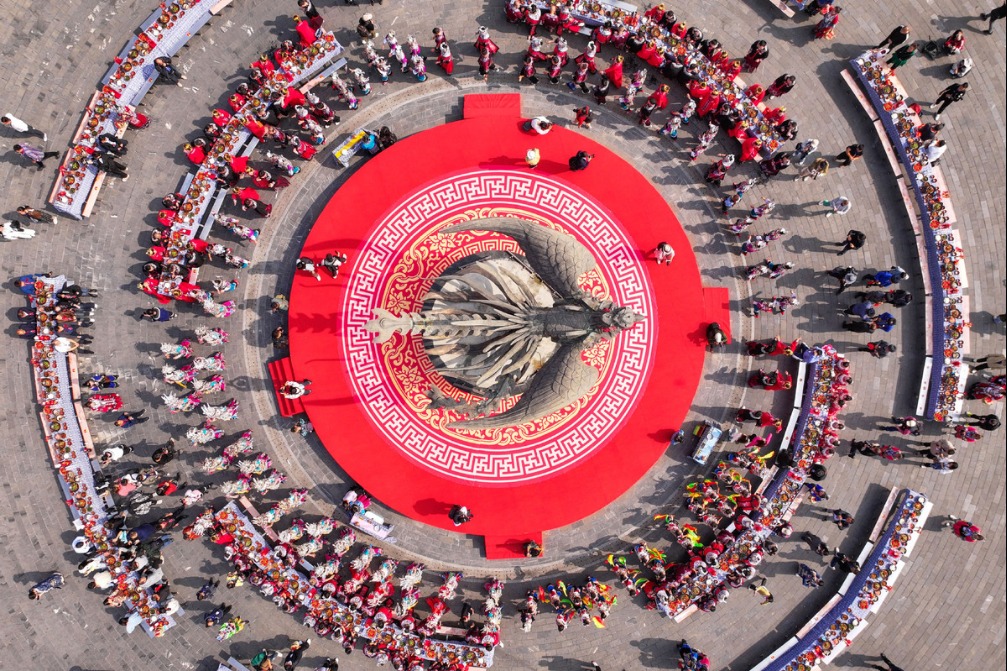Space sector set to rocket into future

Timeline

1. Dec 2, 2013
The Chang'e 3 mission begins, with the aim of sending a robotic probe to the moon. After a 12-day flight, the probe lands, becoming the first Chinese spacecraft to do so and the first craft from any country to achieve the goal in nearly four decades. Yutu, the first Chinese lunar rover, begins operations. It works until July 2016.
2. Nov 3, 2016
China's largest and mightiest carrier rocket, the Long March 5, debuts at the Wenchang Space Launch Center, Hainan province, to transport a scientific-experiment satellite into space. The most technologically sophisticated rocket ever built by China, it has a liftoff weight of 869 metric tons and can carry up to 25 tons into a low-Earth orbit or 14 tons to a geosynchronous transfer orbit. The payload capacity is about 2.5 times larger than that of any other Chinese rocket.
3. Dec 8, 2018
China's fourth lunar probe, Chang'e 4, is launched toward the far side of the moon. After a 26-day journey, the unmanned spacecraft lands in the Von Karman crater, beginning humanity's first close observation of the area. The Yutu 2 rover, the mission's core component, has worked on the moon for nearly 1,400 days and traveled nearly 1,300 meters on the lunar soil, making it the longest-working rover ever.
4. June 5, 2019
A Long March 11 solid-propellant carrier rocket is used for China's first seaborne space launch in its territorial waters. Prior to the mission, scientists had conducted more than 310 carrier rocket launches at China's four land-based space launch centers.
5. July 25, 2019
i-Space, a Beijing startup, becomes China's first private enterprise to successfully conduct an orbital mission. The company launches its first SQX-1 carrier rocket at the Jiuquan Satellite Launch Center in Northwest China, sending two satellites and three experimental payloads into space.

6. July 31, 2020
The domestically developed Beidou Navigation Satellite System is completed, and starts providing full-scale global services. Since 2000, a total of 59 Beidou satellites, including the first four experimental ones, have been launched.

7. Nov 24, 2020
The Chang'e 5 robotic moon mission is launched from Wenchang. After landing on Dec 1, it brings 1,731 grams of lunar rock and soil back to the Earth on Dec 17, about 44 years after the last lunar substances were returned. The 23-day mission makes China the third country to retrieve lunar samples.
8. July 23, 2020
The Tianwen 1 mission, the nation's first independent interplanetary exploration, is launched from Wenchang. The spacecraft consists of two major components — a rover named Zhurong and an unnamed orbiter. It travels more than 470 million kilometers before entering Mars' orbit in February last year. Zhurong touches down on the planet on May 15 last year and begins work on the surface a week later.

9. April 29, 2021
In-orbit construction of the Tiangong space station begins as the Tianhe core module — the first and central component — is launched. The station has three parts: a connection section; a life-support and control section; and a resources section. So far, 12 astronauts have lived in the craft.
10. Oct 31, 2022
The Mengtian space lab module is launched from Wenchang to complete the in-orbit assembly of the Tiangong station. Mengtian, the world's largest single-body spacecraft now in active service, is about 17.9 meters long, has a diameter of 4.2 meters and weighs more than 23 tons. There are 13 science cabinets inside the craft to hold scientific equipment. It also carries 37 extravehicular payload adapters capable of carrying experiments that need to be exposed to the space environment.
- Regulator issues guideline to create a safer online world for minors
- Philippines criticized for violating sovereignty, maritime rights
- Former Palace Museum official under investigation
- Seven villages made it to UNWTO's 'Best Tourism Village' list
- The hundred-bird coat: a cultural treasure of Guizhou
- China to launch cargo craft Tianzhou 8 on Friday night




































